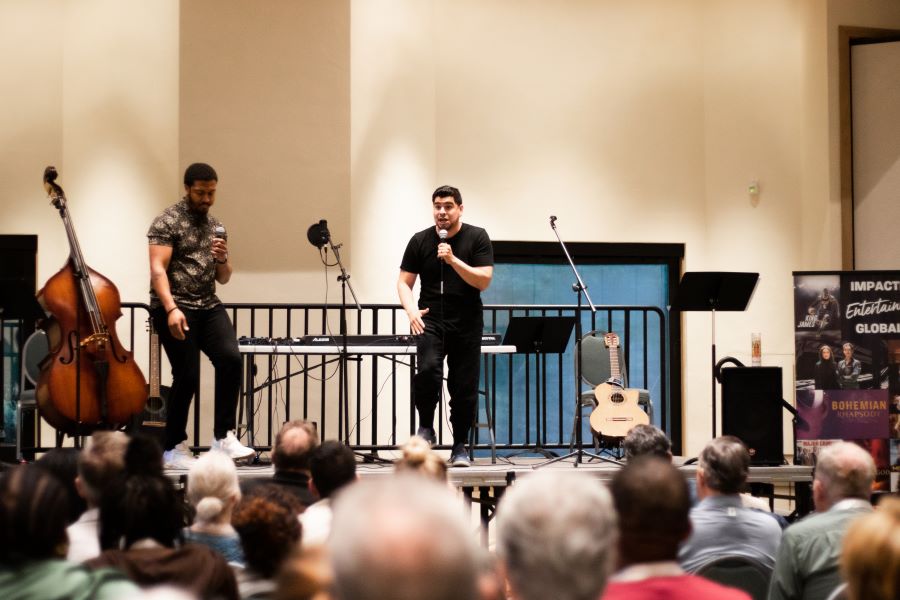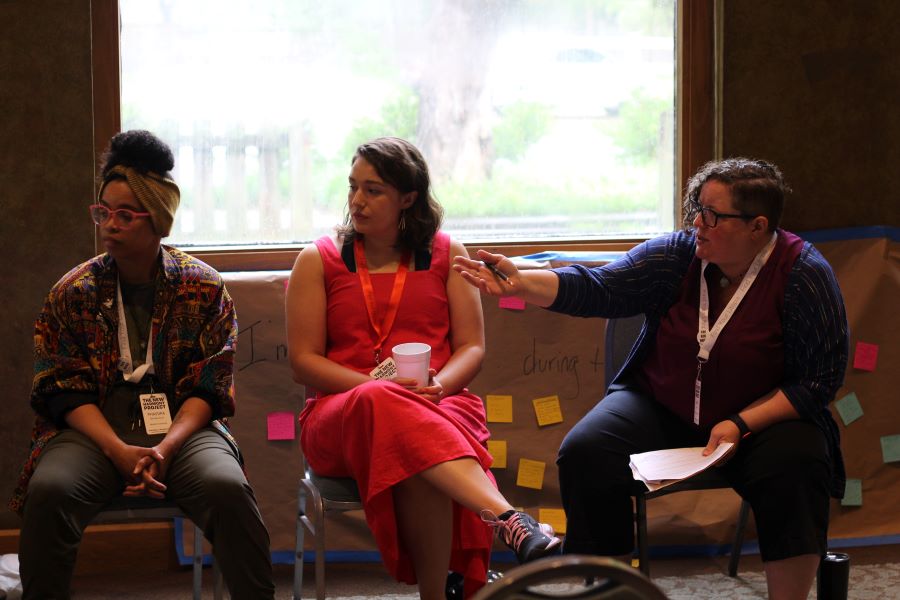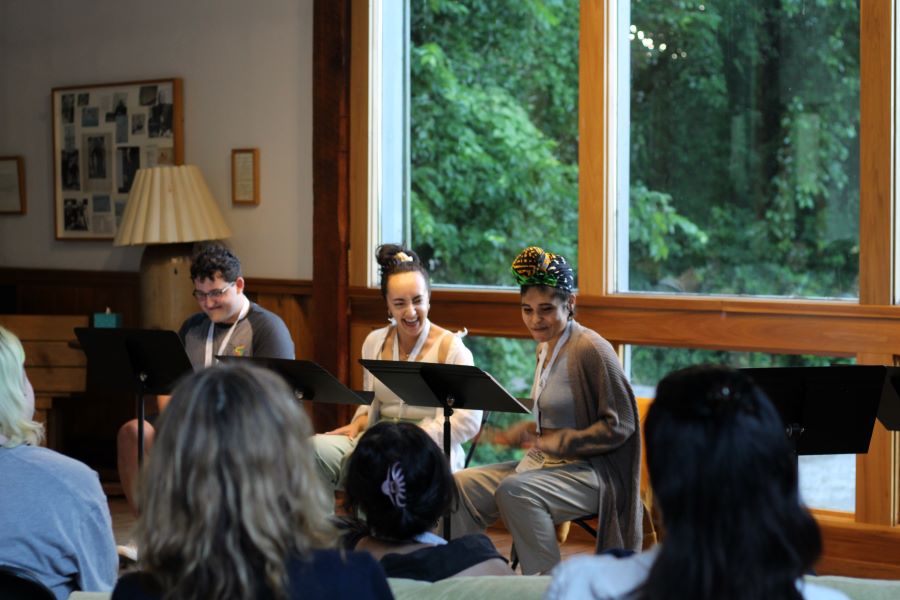Company manager Blake Elliott, Eliana Pipes, and Kirya Traber reading at on of The New Harmony Project’s nightly evening salons. (Photo by Elijah Roberson)
Just about three hours southwest of Indianapolis, nestled against the Wabash River where it carves the border between Indiana and Illinois, sits the small town of New Harmony, Ind. New Harmony boasts a population that doesn’t quite top 700, but it has long punched above its weight in one respect at least: For three decades, the New Harmony Project has offered writers a retreat away from the bustle of major cities to workshop and focus on creating new work. The arts organization’s over 250 alumni since 1986 include the likes of Ngozi Anyanwu, Brian Quijada, DeLanna Studi, and Psalmayene 24. Erika Dickerson-Despenza’s shadowland went through New Harmony, as did Rajiv Joseph’s King James, Idris Goodwin’s How We Got On, and Theresa Rebeck’s Dead Accounts.
But when Jenni Werner joined the company in 2023 as its new executive artistic director, she saw a chance to take a growing organization to a new level by creating a new-play gathering, which she would christen PlayFest Indy.
“New-play programs are either being cut or reduced dramatically,” said Werner, who served as director of literary and artistic development programs for Geva Theatre Center in Rochester, N.Y., for 12 years. “So I was both thinking about how we can serve Indianapolis theatres and how we can serve our writers and offer them more opportunities now that those opportunities are really going away in other places. How do we help to fill in some of the gaps?”
PlayFest Indy is Werner’s answer. This weeklong celebration of new plays, aimed at spotlighting Indianapolis, and Indiana more broadly, as a center for new-play development, kicked off yesterday. The New Harmony Project partnered with eight Indianapolis-area theatre companies and paired them with eight New Harmony alum playwrights. Works featured in this year’s inaugural festival include Lucy Thurber’s Port Isabel, Texas, presented by American Lives Theatre; Erika Dickerson-Despenza’s Audubon, presented by Indianapolis Shakespeare Company; a.k. payne’s Noa, with Naptown African American Theatre Collective; Lina Patel’s Sick Girl, Or Don’t Hate Me ‘Cuz I’m Pretty, with Summit Performance Indianapolis; Aurora Real de Asua’s Wet, with Phoenix Theatre; Jessica Huang’s The Birth of the Pill, with Indiana Repertory Theatre; Keiko Green’s WAD, with Storefront Theatre; and Jordan Ramirez Phuckett’s Huelga, with Fonseca Theatre.
“I don’t think Indiana is often thought of as the place for theatre or the place for new work, and I think it can be,” Werner said. “New work can be just as important as the [Indy 500] or basketball, you know? That’s one of the things I hope we’re able to really build here in Indianapolis and throughout the state: the importance of storytelling onstage and of supporting this kind of work.”
The packed festival kicks off with a two-day retreat for script development sessions with the creative team, followed by workshops with the actors beginning on Sept. 11. Free public readings run Sept. 13-15 at various theatres around the city.
“Being in Indiana, it was a natural progression just to say yes to pretty much whatever Jenni wanted to do,” said Benjamin Hanna, artistic director at Indiana Repertory Theatre, the state’s largest regional theatre. “I love this for institutions outside of IRT, who don’t necessarily have money or resources dedicated to developing new work that could end up on their stages—and we also, of course, struggle to find resources to do that.”

As of 2022, New Harmony’s operating budget sat just above $500,000. Werner said they were able to add an additional $200,000 to the budget in one year to support this effort, thanks to both some of their traditional donors but also to Indianapolis-based donors excited by the idea of their city potentially becoming a creative hub for new-work development. She was also encouraged by the response from local theatres, some who have been interested in developing new work but simply don’t have the infrastructure or capacity to actually dive into the realm of development.
“When you approach someone and you say, ‘Would you like to partner with us on something new, something exciting with no risk to your budget?,’ it sort of takes away the fear,” Werner said. “There is just an excitement around this idea, and a real pride in Indianapolis that people really wanted to uplift and support.”
With the money side of things taken care of, participating theatres were provided a list of New Harmony alumni and were able to choose whose work resonated most closely with them and their theatre’s mission. Werner then helped to connect the theatres and the playwrights for the festival. At Naptown African American Theatre Collective, they were searching for a play that served their mission of celebrating the beauty, power, and humanity of Black stories, which led them to the work of a.k. payne. LaKesha Lorene, NAATC’s CEO, founder, and producing director, said she valued this festival as a chance to introduce her company’s audience, many of whom might be more used to seeing a fully staged production, to a new part of the play development process.
“Honestly, I was just floored at the ambition of a festival this size,” said Lorene, echoing a sentiment voiced by multiple Indianapolis-area theatre leaders. “It’s a great opportunity for me, especially working with a.k. payne, to get to see the work that they do and see how we could possibly work with them, or any of the playwrights that are part of PlayFest Indy, in the future.”
All of the theatre leaders I spoke with talked about the value of being able to build deeper relationships with the artists who have gathered around New Harmony over the years. Hanna said last week that IRT was looking forward to the chance to host intimate events for the playwrights, directors, and dramaturgs coming through town as a way to welcome them to the city and region. Of course, on the business end, the festival is also a chance for Indianapolis theatre leaders to get a close look at playwrights whose works may one day grace their stages as world premieres.
For Phoenix Theatre Cultural Centre artistic director Constance Macy, this is a chance to see and interact with playwrights whose work she may not have encountered before. It’s an opportunity that’s especially important for a theatre that simply can’t produce the volume of work (especially new work) that they might have been able to years ago.

“When Brian Fonseca, the founder, was around running the Phoenix, he would throw up 12 plays a year, and a lot of them were world premieres,” Macy said, “but we just can’t afford that anymore.”
The Phoenix Theatre wound up shifting their model, now bringing in a collective of theatres into their 20,000 feet of performance, rehearsal, and event space. Their current season includes 14 productions ushered to the stage by seven different companies, including some participants in PlayFest Indy, each bringing their own unique mission and programming. This has allowed Macy to focus Phoenix Theatre’s own productions of new work. This season, for instance, they’ll stage National New Play Network rolling world premieres of Snow Fever: a Karaoke Christmas by Robert Caisley, The Berlin Diaries by Andrea Stolowitz and Oak by Terry Guest—a trend that will hopefully be aided by the connections made during PlayFest Indy.
Meanwhile, Indiana Rep is looking at this as a chance to deepen their community’s relationship with a playwright that the company has recently committed to. IRT announced on Monday that Jessica Huang would be joining the company as its new James Still Playwright-in-Residence, serving a three-year appointment as part of the artistic team, advising on new-play development, leading IRT’s young playwrights in process program, and developing her own work as a new commission for the theatre. Huang had her play The Paper Dreams of Harry Chin produced by IRT in 2022, but Hanna and associate artistic director cara hinh saw this festival as an opportunity to share more of Huang’s work with an audience who will be seeing a lot of her over the next three years.
“I’m really excited for the folks here to be able to experience a taste of what some of the new work feels like in New York and on the coasts,” said hinh, a former Drama League Fellow, member of the ‘20-22 Roundabout Directors Group, and fellow at Baltimore Center Stage. “I think why we’re trying to really extend ourselves and be part of making this festival successful, especially for the artists, is to hopefully begin to see how we can invite our IRT community to begin to understand what the process of new-play development looks like.”
Looking ahead, the plan is for PlayFest Indy to become an annual staple in the city, with the New Harmony Project’s Werner adding that they’re exploring ways to expand the festival in the future. She acknowledged that eight readings in one week might be a little jam-packed, so they’ll be looking at potentially extending the festival timeline. That also may allow for the inclusion of more writers, and could lead to such additions as New Harmony writers offering classes or to opportunities to work with writers who call Indianapolis home. After all, it’s the New Harmony Project’s mission not only to support these artists’ work, but to give them the time and opportunity to create community in an environment not driven by the urgency that so regularly plagues the theatre field.
“I know, as a dramaturg, when I’ve done new-play workshops, you often think, ‘Oh, if we just had an extra hour, if we just had a little extra time without the actors here,’” Werner said. “So to have the luxury of that time, and to allow these people to just spend time talking and building community, felt really important. It’s an experiment. We’ll see if it feels as useful to them as I think it might, because I haven’t seen anything like this happen exactly this way before.”
Jerald Raymond Pierce (he/him) is the managing editor of American Theatre. jpierce@tcg.org


